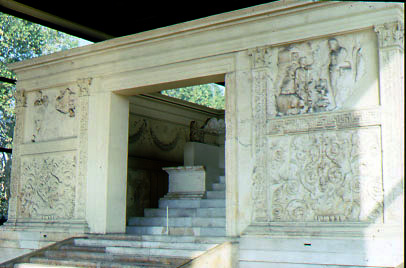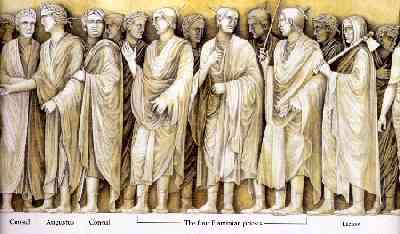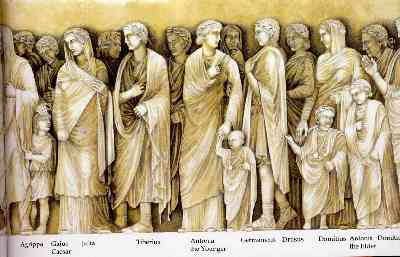ARA PACIS AUGUSTAE - The Altar of Augustan Peace
Plate questions 1983, 1992, 1998
The Decoration
The Altar inside the
screen
A small frieze (39cm
high and 2.58m long) decorates the left side of the altar, representing a
procession to a ceremony of sacrifice, possibly the sacrifice made at the time
of the dedication of the monument in 9BC.
On the inside beneath
the spiral was a procession of Vestal Virgins.
The style of the two friezes on the altar is conservative, like earlier
republican ones rather than the great processions on the exterior of the
screen.
The interior walls of the screen
These are divided into two. The lower sections seem to have been carved to represent fence posts (possibly representing an earlier fence around the sacred site during the construction period). On the top half of the walls hang bulls’ skulls (bucrania), sacrificial bowls (paterae) and garlands of fruit. The fruit in the garlands represent all four seasons, reminding the viewer that Augustus’ power and peace spanned the whole year. There are palmettes between the two levels of the interior screen walls: these, together with the acanthus leaves, are evidence of Greek stylistic influence.
The exterior walls of the screen
It is divided along
its entire length into two – the lower and upper friezes.
The lower frieze
is the same on all sides, depicting elaborate floral designs of acanthus
plants. Amongst the vegetation are
swans, insects, snakes, lizards and frogs – all symbols of fertility and
reminiscent of 4th and 5th century Greece. Swans are also symbols of Apollo, the god
whom Augustus claimed supported him at the Battle of Actium in 31BC.
The upper frieze
is 1.55m high. The East and West panels contain sculptured reliefs containing
mythological symbolism, the longer South and North friezes depict the people in
procession in historical verism.
Details of the
decoration of the upper friezes on each face:
WEST FACE - the entrance flanked by mythological/historical scenes
A
l t a r
S
t e p s
Significance of the decoration on west face:
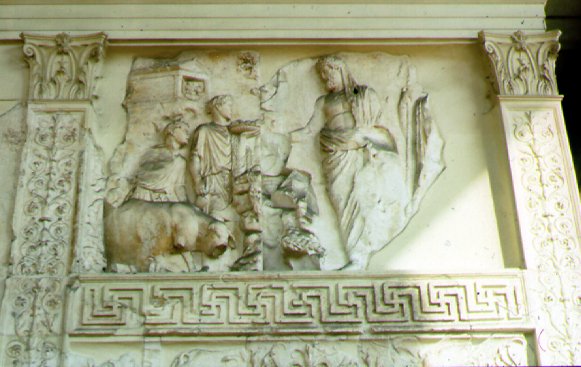
On either side of the entrance are previous leaders/founders of Rome, the details of whose existence are shrouded in myth.
Romulus founded the city of Rome and became its first king in 753 BC.
Aeneas led those Trojans who were left after their city had been destroyed by the Greeks to a new home in Italy. Romulus was descended from Aeneas.
The altar of peace, directly attributed to the actions of Augustus, is seen through the gap between these two early founders of Rome. They metaphorically embrace the third ‘founder ‘– Augustus, the bringer of peace.
EAST FACE - the entrance flanked by mythological/allegorical scenes
Tellus, (Mother Earth) or possibly Italy personified
is seated peacefully holding two plump babies. A cow and sheep graze contentedly
at her feet and there are luxurious flowers and fruit. Possibly the
personification of water and of air are at her side, one on a sea monster
and the other on a swan, or else fresh water is indicated by the jug on the
left and salt water by the waves on the right. This scene is allegorical of
fertile abundance and of the peace achieved by land and sea, for which
every Roman was grateful to Augustus. The armed goddess, Roma, is seated at peace, although
still armed. She is symbolic of Rome having conquered all and now wanting
peace, though prepared to fight to retain land won by war. The scene has been badly damaged.
Significance of the decoration on east face:
This side is allegorical of the peace, prosperity and fertility brought to Rome by the emperor Augustus. The twin babies and animals underscore his legislation encouraging the noble class to increase the population of Rome. Rome has control of earth and sea owing to Augustus’ achievements.
SOUTH FACE – Procession LEFT towards the entrance
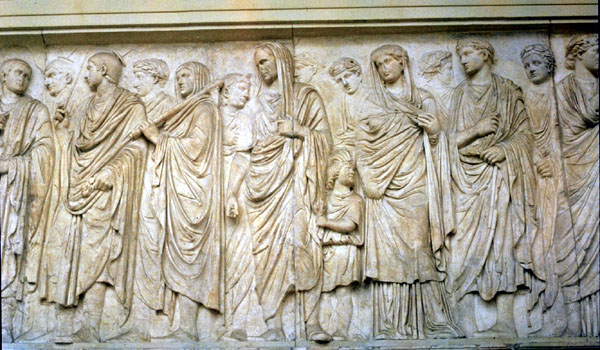
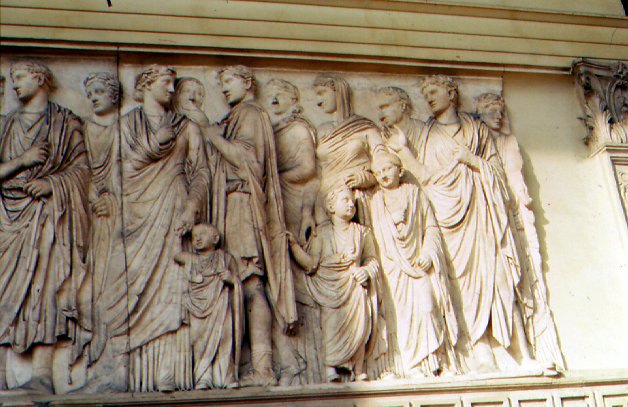
People
are depicted processing on 4th July 23 BC towards the site of
the altar (the west). The emperor and his family are depicted, together
with other state dignitaries, in two planes, the principal characters to
the fore with the lesser participants all interspersed between them in lower
relief. It is thought that Augustus is depicted just
after the damaged section, with his toga over his head, indicating that
he is presiding over the ceremony as Pontifex Maximus – Chief Priest. He
did not in fact take this title until12 BC, after the death of Lepidus,
the previous holder. Note however
that he is presented as being first among equals ‘primus inter pares’, being
the same size as others in the procession and not repeated constantly on
the monument. Four flamines
(other priests) are identified by their hats with spikes, three flamines
maiores and the new priest of Julius Caesar (the last of them in the background).
Then probably follow Marcus Agrippa, who was Augustus’ son-in-law
and admiral, and the small boy, Gaius Caesar – Agrippa’s biological son
and Augustus’ adopted son.
The
lady is likely to be Livia, Augustus’ wife, followed by Tiberius, her son by a
previous marriage and eventual successor of Augustus. The two small children
are probably Antonia Minor and Drusus, other grandchildren of Augustus and the
woman in the background with her hand to her mouth is possibly Octavia, sister
of Augustus and wife of the late Mark Antony.
NORTH FACE – Procession RIGHT towards the entrance
Again
members of the imperial and of senatorial families, including children, process
towards the entrance. The inclusion of
children emphasises the message from the emperor that senatorial families
should be increasing in numbers. The
different height of the children and therefore of the folds of their dress adds
contrast, and a realistic three dimensional touch (also present on the South
side) is the extension of some sandalled feet over the edge of the level on
which the people stand. It is also realistic showing people in the crowd behind
the main characters and the varied directions of the gaze of the
participants. There is ‘visual variety and a rhythm that enlivens
and excites the eye; the procession vibrates with movement.’ This procession is clearly a family
gathering. There is the solemnity of a formal occasion, but also the realism of
children ‘playing up’.
Both North and South
friezes depict a leisurely procession, unhurried and orderly, but with many
people present. Three things are evident:
·
the
family is important
·
a
formal occasion requires reverence (pietas)
and quiet seriousness (gravitas)
·
the people in the
procession are recognisable individuals
Propaganda aspects of the Ara Pacis Augustae
·
The decoration on the
upper northern/southern exterior panels of the altar’s screen commemorates an
important state event – the procession in 13 BC to the site of the altar, to
give thanks for peace.
MESSAGE: Now Rome is at peace (after 100 years or
so of civil disruption and war) and you
have Augustus to thank for that.
·
The decoration on the
upper western exterior panels of the altar’s screen emphasises the divine
origin of Rome and of the Julio-Claudians, of whom Augustus was one.
MESSAGE: Rome has had a great history and it has been
favoured by the gods. Augustus, its ruler, is of divine origin and has family
connections which go back to Rome’s earliest days. He is a devout leader and is
part of the great destiny which the gods plan for Rome.
Augustus always stopped short of allowing himself to be regarded as divine, certainly in Rome. In far eastern provinces, where there was a tradition of rulers being regarded as gods, there occurs the beginning of Emperor worship, but elsewhere in the Empire, Romans were generally willing to regard leaders as gods once they were safely dead (remember what happened to Julius Caesar in 44 BC).
·
The decoration on the
left upper eastern and all the lower exterior panels of the altar’s screen
emphasises the theme of Peace (brought about by Augustus) and the resultant
prosperity and fertility.
MESSAGE: Rome now has the best possible conditions
(peace and stability) for all things to grow and prosper and you have Augustus to thank for that.
·
The decoration of the
interior of the screen emphasises the favourable relationship of Rome with the
gods (pietas) through worship, correctly organised and performed ceremonial and
sacrifice. This helps to bring prosperity and fertility to the nation.
MESSAGE: Now that
Augustus is the ruler (and leading by
example in paying due attention to the gods) you can have confidence that Rome is destined to be a nation which will
continue to flourish.
·
The fact that
children feature prominently on both the North and South friezes emphasises the
importance Augustus placed on the concept of family.
Augustus endeavoured to encourage the growth of senatorial families by passing laws giving
1. advantage to men standing for public office, if they had fathered children.
2. tax incentives for couples to have more than three children
3. penalties for men and women who remained single or childless.
Needless to say, people found ways to get around such legislation, which by its very nature of dealing with people’s private lives, is difficult to enforce.
MESSAGE: If Rome is to
flourish in the future as the gods intend, citizens are going to have to play
their part by strengthening the ruling families, as Augustus has pointed
out -
and
Augustus is father of his family (paterfamilias) and
father of his fatherland (pater patriae).
Sadly for Augustus he failed to produce a male heir himself. His first appointed heir was his nephew Marcellus, who died of ‘food poisoning’ while still a young man. Next appointed was Agrippa, his son-in-law, but being of similar age to Augustus, he predeceased him. Then two grandsons (children of Julia, his daughter, and Agrippa) became heirs, but they died accidentally too when young men in the Roman army. Augustus was forced to accept Tiberius, his wife Livia’s son from her first marriage, as his heir, and he indeed became the second emperor of Rome.
The structure as a
whole promotes Augustus’ imperial ideology on a scale and in a manner that is
unprecedented. He aligns himself with
historical realism in the North and South friezes, and with the mythological
symbolism of the East and West panels. The viewer is reminded repeatedly of the
greatness of Augustus and of Rome.
‘The Ara Pacis Augustae’ marks a turning point not only in
the artistic development of the Empire but also in the use of art for
propaganda. No Roman looking at the Ara
Pacis could have failed to be overwhelmed by a sense of relief at the passing
of the horrors of the Republican age.
He would have looked forward to a stable future secure in his belief in
the new leadership of the princeps’
(=Augustus). Source of quotation?
